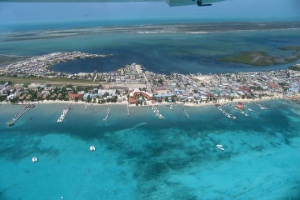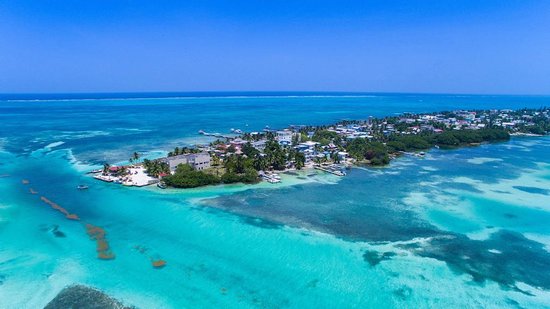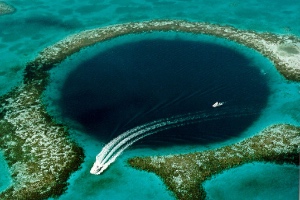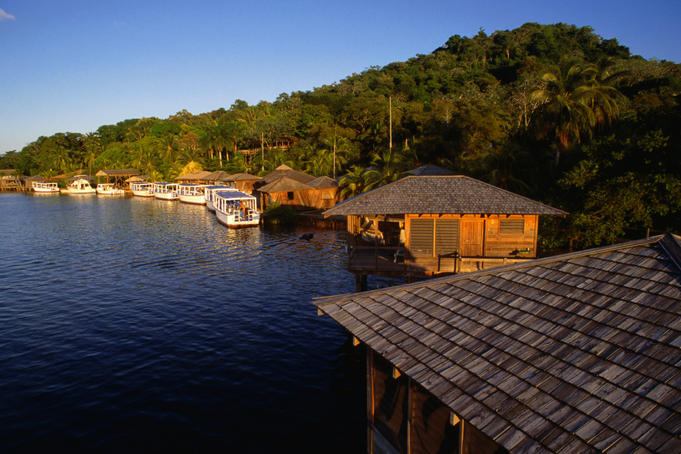Traveling through Belize you will see the sign, “No Shirt, No Shoes…No Problem!” nearly everywhere you go. This relaxed approach to life is only part of what is attracting more and more visitors to Belize each year.
 Located between Mexico to the north, Guatemala to the west and south and the Caribbean Sea to the east, Belize is a country of contrasts. Belize may be the only country in Central America where English is the official language, but Belize has a diverse society, composed of many cultures and speaking many languages and, culturally, Belize considers itself to be both Caribbean and Central American.
Located between Mexico to the north, Guatemala to the west and south and the Caribbean Sea to the east, Belize is a country of contrasts. Belize may be the only country in Central America where English is the official language, but Belize has a diverse society, composed of many cultures and speaking many languages and, culturally, Belize considers itself to be both Caribbean and Central American.
And, because over 40 of Belize’s mass is a protected national park, wildlife sanctuary or marine reserve, there is no shortage of wildlife. Sharks, coral fish, dolphins and turtles troll the waters, and over 570 species of birds, including toucans, fly the skies.
 Caye Caulker – one of the tiny islands off of the Belize coast – is a great place to observe the culture of Belize, while staying within a budget. In fact, this island has been a stop for backpackers and college travelers for decades! Many of the residents of Caye Caulker are fishermen, making the island a great place to get fresh spiny lobster and snapper. There are no cars on Caye Caulker but there are plenty of beaches, friendly locals and delicious food.
Caye Caulker – one of the tiny islands off of the Belize coast – is a great place to observe the culture of Belize, while staying within a budget. In fact, this island has been a stop for backpackers and college travelers for decades! Many of the residents of Caye Caulker are fishermen, making the island a great place to get fresh spiny lobster and snapper. There are no cars on Caye Caulker but there are plenty of beaches, friendly locals and delicious food.
Another must see while in Belize is Crooked Tree Wildlife Sanctuary, named after the cashew trees that inhabit the village. For $8 you get access to the community that is actually home to 900 locals, of Creole descent, who have been farming and fishing the area for generations. If you make it there in the morning, you’ll also get to see the amazing variety of birds that inhabit the area and make this one of the top birding destinations in the world.
After you’ve conquered Belize by land, venture seaward and see Belize’s Hol Chanand the Great Blue Hole. Hol Chan, also known as “Shark-Ray Alley,” is an split in the reef where nurse sharks and sting rays among other marine life, make their home. Besides being a prime destination for dive excursions, Hol Chan is also a marine reserve.
 First made famous by Jacques Cousteau, the Great Blue Hole is a large underwater sinkhole that can be seen from space! The world’s largest feature of its kind, the Hole attracts divers looking to catch a glimpse of the nurse sharks, Caribbean reef sharks and Blacktip sharks that live in the area. Dive trips to the Great Blue Hole are usually full-day trips, including a dive in the Blue Hole and two other dives in nearby reefs.
First made famous by Jacques Cousteau, the Great Blue Hole is a large underwater sinkhole that can be seen from space! The world’s largest feature of its kind, the Hole attracts divers looking to catch a glimpse of the nurse sharks, Caribbean reef sharks and Blacktip sharks that live in the area. Dive trips to the Great Blue Hole are usually full-day trips, including a dive in the Blue Hole and two other dives in nearby reefs.
Whatever attracts you to Belize, the warmth of the local culture will make you feel you’ve found a second home. Actually, many visitors have made it their second home – and when the owners are away, why not take advantage of the great deals to be had by renting a vacation house in Belize rather than paying a nightly rate for a hotel?

 The second largest island in the Galapagos archipelago is the island of Santa Cruz, which might be called the focal point of Galapagos’ Tourism.
The second largest island in the Galapagos archipelago is the island of Santa Cruz, which might be called the focal point of Galapagos’ Tourism. 
 There is no shortage of entertainment in Santa Cruz – visitors can go mountain biking, kayaking, scuba diving, horseback riding, surfing, or take a jeep tour on land or a glass bottom boat tour on the ocean. If you need a break, have a drink at an outdoor bar in Puerto Ayora.
There is no shortage of entertainment in Santa Cruz – visitors can go mountain biking, kayaking, scuba diving, horseback riding, surfing, or take a jeep tour on land or a glass bottom boat tour on the ocean. If you need a break, have a drink at an outdoor bar in Puerto Ayora. “I met up with a blue-footed booby standing smack in the middle of the footpath. It made no offer to step aside and let me pass. Looking into its birdy eye, I saw . . . nothing at all. No fear, but also no aggression. No anxiety, affection, hope, recognition. Its indifference was profound, as if I were invisible, although I’d been told that if I did step too close it might jab at me with its beak. This strange fearlessness can’t be explained by any local history of kindness on the part of man. Even Darwin killed birds and ate tortoises. The blue-footed booby wasn’t afraid of me, but the name for this is not tameness. It’s genetic innocence. Since the animals evolved in the absence of man, their innocence exists at a molecular level. I saw it again in the eye of an albatross just before it turned to begin its mating dance; I saw it in the stare of a sea lion nursing her pup on the beach. The animals felt nothing for people one way or the other, yet all around them were people, including me, in love with the animals.”
“I met up with a blue-footed booby standing smack in the middle of the footpath. It made no offer to step aside and let me pass. Looking into its birdy eye, I saw . . . nothing at all. No fear, but also no aggression. No anxiety, affection, hope, recognition. Its indifference was profound, as if I were invisible, although I’d been told that if I did step too close it might jab at me with its beak. This strange fearlessness can’t be explained by any local history of kindness on the part of man. Even Darwin killed birds and ate tortoises. The blue-footed booby wasn’t afraid of me, but the name for this is not tameness. It’s genetic innocence. Since the animals evolved in the absence of man, their innocence exists at a molecular level. I saw it again in the eye of an albatross just before it turned to begin its mating dance; I saw it in the stare of a sea lion nursing her pup on the beach. The animals felt nothing for people one way or the other, yet all around them were people, including me, in love with the animals.” Morro de Sao Paulo (St. Paul’s Hill) is just about as good as it gets when it comes to a laid back vacation destination. And while the island is not far from easy-to-get-to locations like Salvador, the small town has no cars and a much slower-paced lifestyle despite its popular nightlife.
Morro de Sao Paulo (St. Paul’s Hill) is just about as good as it gets when it comes to a laid back vacation destination. And while the island is not far from easy-to-get-to locations like Salvador, the small town has no cars and a much slower-paced lifestyle despite its popular nightlife. The Northeast coast of Brazil is famous for its
The Northeast coast of Brazil is famous for its  However, Second Beach is more than a party – one of Brazil’s most famous cultural arts, Capoeira, is preformed here every evening. With the setting sun as the backdrop for this acrobatic martial art, you will not want to miss this! Ask around for performance locations or simply follow the crowd!
However, Second Beach is more than a party – one of Brazil’s most famous cultural arts, Capoeira, is preformed here every evening. With the setting sun as the backdrop for this acrobatic martial art, you will not want to miss this! Ask around for performance locations or simply follow the crowd!
 Roatan is a scuba diviers paradise. Located off of the North Coast of Honduras,
Roatan is a scuba diviers paradise. Located off of the North Coast of Honduras,  If you’ve never been to Roatan, you can plan on using your US dollars rather than the local lempiras as US currency is accapted, even welcomed, nearly everywhere. Do keep an eye out for favorable conversion rates and cash in if and when it makes sense. Also, expect to see a heavy military presence. There is almost guaranteed to be an AK-47 wielding guard at the enterence to most establsihments – they keep a low profile and it is the general consensus that Honduras is safer for locals and tourists alike since the new government has implemented this military presence.
If you’ve never been to Roatan, you can plan on using your US dollars rather than the local lempiras as US currency is accapted, even welcomed, nearly everywhere. Do keep an eye out for favorable conversion rates and cash in if and when it makes sense. Also, expect to see a heavy military presence. There is almost guaranteed to be an AK-47 wielding guard at the enterence to most establsihments – they keep a low profile and it is the general consensus that Honduras is safer for locals and tourists alike since the new government has implemented this military presence. If you’ve never been wreck diving, “El Aguila” is an amazing sight – a 210′ cargo boat perfectly sunk in 100 feet of water on a sandy bottom full of Deep Garden Eels. Divers can descend onto open large compartments where you can surprise a number of fish in their homes! The wreck runs alongside a wall where many choose to finish off their dive among the shallow water tropical fish.
If you’ve never been wreck diving, “El Aguila” is an amazing sight – a 210′ cargo boat perfectly sunk in 100 feet of water on a sandy bottom full of Deep Garden Eels. Divers can descend onto open large compartments where you can surprise a number of fish in their homes! The wreck runs alongside a wall where many choose to finish off their dive among the shallow water tropical fish.